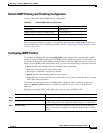
20-20
Catalyst 2960 Switch Software Configuration Guide
78-16881-01
Chapter 20 Configuring IGMP Snooping and MVR
Configuring MVR
To return the switch to its default settings, use the no mvr [mode | group ip-address | querytime | vlan]
global configuration commands.
This example shows how to enable MVR, configure the group address, set the query time to 1 second
(10 tenths), specify the MVR multicast VLAN as VLAN 22, and set the MVR mode as dynamic:
Switch(config)# mvr
Switch(config)# mvr group 228.1.23.4
Switch(config)# mvr querytime 10
Switch(config)# mvr vlan 22
Switch(config)# mvr mode dynamic
Switch(config)# end
You can use the show mvr members privileged EXEC command to verify the MVR multicast group
addresses on the switch.
Configuring MVR Interfaces
Beginning in privileged EXEC mode, follow these steps to configure Layer 2 MVR interfaces:
Command Purpose
Step 1
configure terminal Enter global configuration mode.
Step 2
mvr Enable MVR on the switch.
Step 3
interface interface-id Specify the Layer 2 port to configure, and enter interface configuration
mode.
Step 4
mvr type {source | receiver} Configure an MVR port as one of these:
• source—Configure uplink ports that receive and send multicast data as
source ports. Subscribers cannot be directly connected to source ports.
All source ports on a switch belong to the single multicast VLAN.
• receiver—Configure a port as a receiver port if it is a subscriber port and
should only receive multicast data. It does not receive data unless it
becomes a member of the multicast group, either statically or by using
IGMP leave and join messages. Receiver ports cannot belong to the
multicast VLAN.
The default configuration is as a non-MVR port. If you attempt to configure
a non-MVR port with MVR characteristics, the operation fails.
Step 5
mvr vlan vlan-id group [ip-address] (Optional) Statically configure a port to receive multicast traffic sent to the
multicast VLAN and the IP multicast address. A port statically configured as
a member of a group remains a member of the group until statically removed.
Note In compatible mode, this command applies to only receiver ports. In
dynamic mode, it applies to receiver ports and source ports.
Receiver ports can also dynamically join multicast groups by using IGMP
join and leave messages.
Step 6
mvr immediate (Optional) Enable the Immediate-Leave feature of MVR on the port.
Note This command applies to only receiver ports and should only be
enabled on receiver ports to which a single receiver device is
connected.
Step 7
end Return to privileged EXEC mode.


















